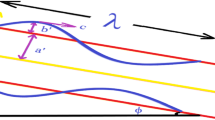Abstract
An accurate approach is proposed for calculating the thermodynamic properties of water in three states: liquid, steam and ice, and the transitional states among them. The formulation is expressed in terms of quantities that are naturally used in Computational Fluid Dynamics (CFD), namely the specific volume (v) and specific internal energy (u), through the use of Gibbs free energy. The Gibbs free energy formula proposed by IAPWS, formulated as a function of pressure and temperature, is used as a basis in our calculations. The Jacobian matrix resulting from the transformation between sets of variables (p, T) and (v, u) are derived for each phase; the Newton-Raphson method is used to iteratively solve the nonlinear equations. Numerical calculations have been carried out for the entire phase diagram covering all three phases. The numerical results are compared with the original data of IAPWS and the associated errors are analyzed. It is confirmed that the pressure and temperature are accurately calculated, with largest relative error on the order of 10−7 in the ice phase. Hence, other thermodynamic properties are also obtained within the same level of accuracy. The method proposed in this paper for calculating pressure and temperature, variables needed in CFD, is reliable and can be applied to the numerical simulation of multiphase flows, including phase changes.
Similar content being viewed by others
References
P. P. Wegener and L. M. Mack, Condensation in Supersonic and Hypersonic Wind Tunnels, Advances in Applied Mechanics, edited by Dryden / Karman, Academic, 5 (1958) 307–447.
G. H. Schnerr and U. Dohrmann, Transonic Flow around Airfoils with Relaxation and Energy Supply by Homogeneous Condensation, AIAA J. 28 (1990) 1187–1193.
A. Berg, U. Iben, A. Meister and J. Schmidt, Modeling and Simulation of Cavitation in Hydraulic Pipelines Based on the Thermodynamic and Caloric Properties of Liquid and Steam, Shock Waves, 14 (2005) 111–121.
J. W. Tester and M. Modell, Thermodynamics and its Applications, third Ed. Prentice Hall International Series in the Physical Chemical Engineering Sciences (1996).
Z. Xu and S. I. Sandler, Temperature -Dependent Parameters and the Peng-Robinson Equation of State, Ind. Eng. Chem. Res., 26(3) (1987) 601–606.
W. Wagner, et. al, The IAPWS Industrial Formulation 1997 for the Thermodynamic Properties of Water and Steam, J. of Engineering for Gas Turbines and Power, 122 (2000) 150–182.
Erlangen, The International Association for the Properties of Water and Steam, (Release on the IAPWS Industrial Formulation 1997 for the Thermodynamic Properties of Water and Steam), Germany, (1997) 1–48.
R. Feistel and W. Wagner, A New Equation of State for H2O Ice Ih, J. Phys. Chem. Ref. Data, 35(2) (2006) 1021–1047.
W. Wagner, A. Saul and A. Pruss, International Equations for the Pressure along the Melting and along the Sublimation Curve of Ordinary Water Substance, J. Phys. Chem. Ref. Data, 23(3) (1994) 515–527.
W. Wagner and A. Pruss, International Equation for the Saturation Properties of Ordinary Water Substance. Revised According to the International Temperature Scale of 1990, J. Phys. Chem. Ref. Data, 22(3) (1993) 783–787.
S. C. Chapra and R. P. Canale, Numerical Methods for engineers, Fifth Ed. McGraw-Hill, New York, USA (2007).
Author information
Authors and Affiliations
Corresponding author
Additional information
This paper was recommended for publication in revised form by Associate Editor Jun Sang Park
Meng-Sing Liou is a Senior Technologist of GRC, for Airbreathing Propulsion Computational Analysis. He has more than 30 years experiences in Computational Fluid Dynamics, contributing in the development of numerical methods and supporting NASA’s aeronautics programs since joining NASA in 1986. His AUSM schemes have been adopted in major commercial and research codes, and included in textbooks and CFD courses worldwide. Currently he is leading the Multidisciplinary Design Analysis and Optimization research in the Aeropropulsion Division to support Fundamental Aeronautics Program. He was Chief of Computational Fluid Dynamics. He was awarded NASA’s Exceptional Scientific Achievement Medal (1992) and Exceptional Achievement Medal (2004), and the Abe Silverstein Medal (2006). He has published over 200 technical papers, and 8 book chapters. He also gave numerous short courses in various countries. He is an Adjunct Professor of University of California, Santa Barbara and Case Western Reserve University.
Jang-Chang Lee received his B.S. and M.S. degrees in Mechanical Engineering from Chung-Ang University, Korea, in 1989 and 1991, respectively. He then received his Ph.D. degrees from R.P.I. in 2000. Dr. Lee is currently a Professor at Department of Mechanical Engineering at Andong National University in Andong, Korea. Dr. Lee’s research interests include Two-phase flows, Aerodynamics.
Rights and permissions
About this article
Cite this article
Lee, JC., Liou, MS. Accurate calculation of the pressure and temperature of water, steam, and ice: Formulation for CFD. J Mech Sci Technol 24, 2333–2340 (2010). https://doi.org/10.1007/s12206-010-0906-2
Received:
Revised:
Accepted:
Published:
Issue Date:
DOI: https://doi.org/10.1007/s12206-010-0906-2




